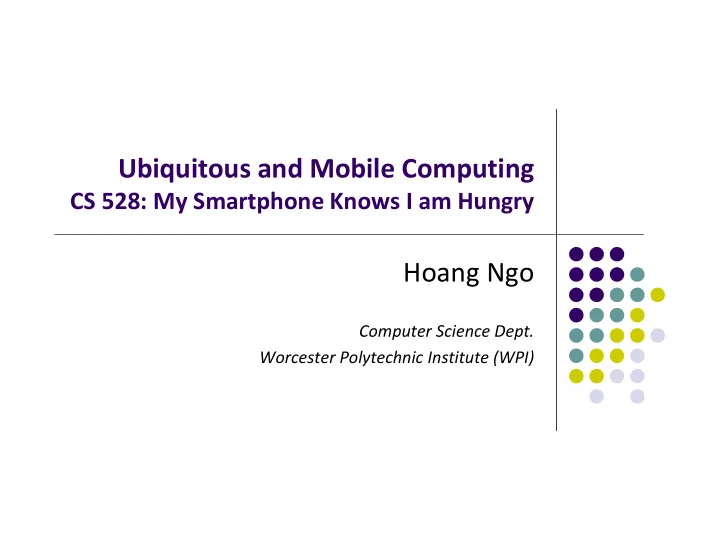

Ubiquitous and Mobile Computing CS 528: My Smartphone Knows I am Hungry Hoang Ngo Computer Science Dept. Worcester Polytechnic Institute (WPI)
Smartphone and Unhealthy Eating
25 Students 10 weeks Run in background 24/7 Collect: Conversation Physical activity Sleep Location Wifi scan log & Bluetooth colocation
Result After 3 week training data, we can predict food purchases with accuracy 74%
Other related researches
Differences
Differences
Simple binary classification problem NOT Buying Buying
Methodology Collect Train Online Training Prediction Predict Data Model
Collect Data Training Features + Current building + Physical activity + Arrival time + Sociability
Why?
Train Prediction Model Classification and Regression Tree Gini impurity (CART) http://en.wikipedia.org/wiki/Decision_tree_learning#Gini_impurity
Predict
Design CART + Gini Impurity
Prediction Model and Traversal
Can we do better?
Implementation Enhancement Personalization Adaptation
Behaviors Schedules Locations
Implementation Enhancement Personalization Adaptation
Eating time in a month
Results Importance of different features (top 6) Prediction Performance
Results Importance of different features (top 6) Current building Arrival time at current building Departure time from previous building Activity ratio in last building Departure time from current building Conversation duration Prediction Performance
Results Importance of different features (top 6) Prediction Performance
Terminology Accuracy measures how well a binary classification test correctly identifies labels Precision measures the probability that a test case given positive label is truly positive Recall measures the probability that a positive case can be identified by the classifier
Prediction Performance 80 74.2 73.9 68.6 70 60 55.1 53.6 52.7 50.5 50.4 49.3 49.5 50 42.1 40 30 26.6 20 10 0 Prediction Baseline Generic Model Personalized Model (5 weeks Personalized Model with training) Adaptation Accuracy Precision Recall
Personalized Model without Adaptation
Personalized Model with Adaptation
Conclusion Feature importance Model to predict eating habit
Future Researches To generalize the work, explore more features for prediction of more types of food purchases Purchase cost Purchase type Total number of daily purchase instance New target users: Office workers How to unobtrusively detect eating? Food intervention
References Amft, O., and Tröster, G. Recognition of dietary activity events using on ‐ body sensors. Artificial Intelligence in Medicine 42, 2 (2008), 121–136. Flegal, K. M., Carroll, M. D., Ogden, C. L., and Johnson, C. L. Prevalence and trends in obesity among us adults, 1999 ‐ 2000. Jama 288, 14 (2002), 1723–1727. Hebden, L., Cook, A., van der Ploeg, H. P., and Allman ‐ Farinelli, M. Development of smartphone applications for nutrition and physical activity behavior change. JMIR Research Protocols 1, 2 (2012). Breiman, L., Friedman, J., Stone, C. J., and Olshen, R. A. Classification and regression trees. CRC press, 1984 Feunekes, G. I., de Graaf, C., Meyboom, S., and van Staveren, W. A. Food choice and fat intake of adolescents and adults: associations of intakes within social networks. Preventive medicine 27, 5 (1998), 645–656. Lowry, R., Galuska, D. A., Fulton, J. E., Wechsler, H., Kann, L., and Collins, J. L. Physical activity, food choice, and weight management goals and practices among us college students. American Journal of Preventive Medicine 18, 1 (2000), 18–27 Menze, B. H., Kelm, B. M., Masuch, R., Himmelreich, U., Bachert, P., Petrich, W., and Hamprecht, F. A. A comparison of random forest and its gini importance with standard chemometric methods for the feature selection and classification of spectral data. BMC bioinformatics 10, 1 (2009), 213. Reddy, S., Parker, A., Hyman, J., Burke, J., Estrin, D., and Hansen, M. Image browsing, processing, and clustering for participatory sensing: lessons from a dietsense prototype. In Proceedings of the 4th workshop on Embedded networked sensors (2007), ACM, pp. 13–17. Rabbi, M., Ali, S., Choudhury, T., and Berke, E. Passive and in ‐ situ assessment of mental and physical well ‐ being using mobile sensors. In Proceedings of the 13th international conference on Ubiquitous computing (2011), ACM, pp. 385–394. Wang, R., Chen, F., Chen, Z., Li, T., Harari, G., Tignor, S., Zhou, X., Ben ‐ Zeev, D., and Campbell, A. T. StudentLife: Assessing mental well ‐ being, academic performance and behavioral trends of college students using smartphones. In Proceedings of the 2014 ACM Conference on Ubiquitous Computing (2014), ACM.
Recommend
More recommend